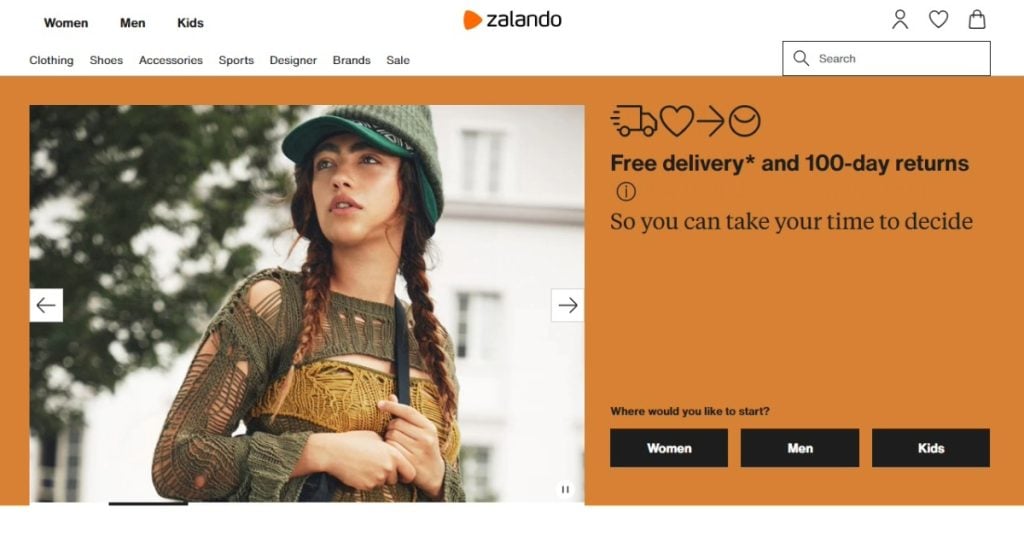
Zalando marketplace case study: book a demo to start yours
Zalando, a premier European online fashion and lifestyle retailer, presents an extensive selection of clothing, footwear, and accessories for men, women, and children. If you’d like to start your own marketplace like Zalando, you’re facing a buy vs build decision. So before you decide to build it in-house on top of Spree open-source, consider using the feature-rich Enterprise Edition cutting your time-to-market to a few weeks.
Build vs Buy a marketplace?
Open-source offers many benefits, including full ownership and the ability to tailor freely, but these come at a price. The process of developing a complete marketplace solution is both time-intensive and costly, typically requiring several months or even years. This understanding is based on our experiences with a range of marketplace initiatives.
To accelerate time-to-market and minimize the risks inherent in custom development, it’s far more effective to launch with a proven, enterprise-grade solution like Spree Commerce Enterprise Edition—trusted by experts who have seen first-hand how challenging and costly marketplace projects can become when built from scratch.
Back to the Zalando marketplace case study
Zalando is an online fashion retailer that offers a user-friendly and easily accessible way for customers to buy apparel and accessories from a variety of brands and designers.
Zalando, established in 2008 in Germany, has rapidly grown to be one of Europe’s leading online fashion retailers. Initially inspired by the US-based Zappos.com, Zalando began with a modest selection of shoes and quickly expanded to a wide array of fashion products. The company’s rise is notable for its speed and scale, with operations now spanning across 14 European countries.
A key aspect of Zalando’s success is its extensive product range. The platform offers a diverse array of items from over 4,500 international brands, catering to a broad European market with localized offerings. This variety ranges from well-known global names to exclusive in-house private labels, ensuring a wide appeal.
Zalando’s innovative business ventures, such as Zalon for personalized style advice and Zalando Fulfillment Solutions (ZFS) for logistics, have further enhanced its market presence. These services not only improve the customer experience but also provide comprehensive support to fashion businesses in navigating the digital landscape.
The company’s focus on customer engagement is evident in its increasing site visits, which saw a substantial rise in 2020. The shift towards mobile shopping is also significant, with a considerable increase in mobile site visits. Active customer growth is another testament to Zalando’s success, with a notable jump in numbers in 2020.
Zalando’s platform-based business model, combined with its commitment to customer satisfaction and technological innovation, positions it as a key player in the online fashion industry. This approach has enabled Zalando to navigate and thrive in a competitive market, balancing rapid expansion with strategic investments in new business fields and marketing strategies.
How to emulate Zalando marketplace success?
To achieve a level of success similar to Zalando, you should think about launching your marketplace sooner rather than later, ideally in weeks rather than months. Check how well your range of products meets the needs of your audience. Continuously refine your customer acquisition strategies based on real experiences.
Test the waters of the market before you dive into building it yourself.
Here’s how to get started:
- Book a marketplace demo call: We’ll help you evaluate Spree for your marketplace needs and get started with the Enterprise Edition
- Customize your Storefront: Use the drag & drop page builder or custom CSS
- Onboard Brands: Invite your brands or choose brands from our catalog
- Select Products: Curate products and collections manually or automate it
- Embed products: Make your content, newsletters, social media shoppable
- Get Paid: Get paid as soon as products are shipped by the brands
- End-to-end automation: brands sync, fulfillment, payouts, invoicing, taxes
When you’ve tried all that and it works, start thinking about building your own, custom-made marketplace project based on Spree Commerce. First, by decoupling the storefront and going headless with marketplace API, and later with your own backend, if you decide you really need it. Just lift and shift the storefront.
Nobody has to know what’s under the hood, right?



